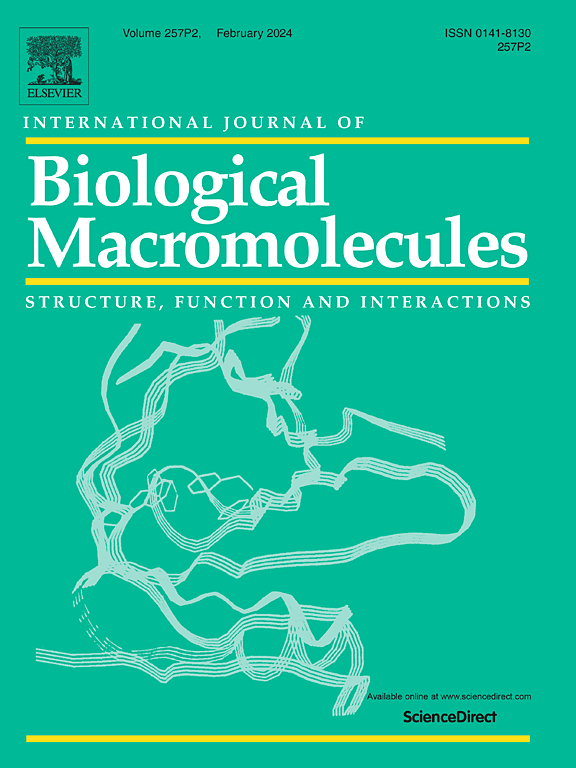邻苯二甲酸盐通过调节乳酸脱氢酶活性诱导大鼠肝脏代谢和氧化还原稳态的破坏:来自毒物动力学和计算分析的见解
IF 8.5
1区 化学
Q1 BIOCHEMISTRY & MOLECULAR BIOLOGY
International Journal of Biological Macromolecules
Pub Date : 2025-08-22
DOI:10.1016/j.ijbiomac.2025.147084
引用次数: 0
摘要
邻苯二甲酸酯是由邻苯二甲酸及其成分产生的新兴和普遍的环境污染物,主要用作包装材料和玩具等聚氯乙烯产品的增塑剂。它们的广泛使用和浸出潜力引起了人们对接触和人类健康的关注。邻苯二甲酸酯是公认的内分泌干扰剂,可显著改变肝酶的活性。本研究设想评估邻苯二甲酸二环己基酯(DCHP)和邻苯二甲酸二异壬基酯(DiNP)对大鼠肝脏乳酸脱氢酶(LDH)催化可逆反应动力学的毒理学影响。在pH值为7.4,温度为37℃,pH值为6.6,温度为47℃的条件下,该酶的正向和反向反应活性最佳。在邻苯二甲酸酯(DCHP和DiNP)不存在的情况下,该酶对正向反应的底物Km较低,而对逆向反应的底物Km较高。然而,邻苯二甲酸酯引起混合酶抑制并改变了毒性动力学参数。此外,IC50、t1/2和Ki值表明DCHP在正向反应和反向反应中更有效地破坏了LDH的功能。芯片分析显示,DCHP和DiNP诱导了LDH移动环、活性位点和底物结合位点(Arg169、Arg171)的构象变化,导致LDH内的位阻。结合亲和力和Ki证实DCHP比DiNP更能抑制LDH的正向反应。这些发现表明,邻苯二甲酸盐诱导结构重排损害了LDH的催化功能,并通过调节LDH活性显著破坏糖酵解代谢和能量产生。本文章由计算机程序翻译,如有差异,请以英文原文为准。

Phthalate-induced disruption of metabolic and redox homeostasis in rat liver via modulation of lactate dehydrogenase activity: Insights from toxicokinetic and computational analyses
Phthalates represent the emergent and pervasive environmental pollutants derived from phthalic acids and their constituents, primarily used as plasticizers in polyvinyl chloride products such as packaging materials and toys. Their extensive use and leaching potential raise concerns about exposure and human health. Phthalates are recognized as endocrine-disrupting agents that significantly modify the hepatic enzymes' activities. This study has envisaged assessing the toxicological impact of dicyclohexyl phthalate (DCHP) and diisononyl phthalate (DiNP) on the kinetics of lactate dehydrogenase (LDH) catalyzed reversible reaction in rat liver. The forward and reverse reactions catalyzed by the enzyme, demonstrating the optimal activity at pH 7.4, temperature 37 °C, and pH 6.6, temperature 47 °C, respectively. The enzyme showed a low Km for substrate of the forward reaction while exhibiting a high Km for the substrates of the reverse reaction in the absence of phthalates (DCHP and DiNP). However, the phthalates induced mixed enzyme inhibition and altered the toxicokinetic parameters. Additionally, the IC50, t1/2, and Ki values indicated that DCHP impaired the function of LDH more effectively in both the forward and reverse reactions. The in-silico analysis revealed that DCHP and DiNP induced conformational changes in the mobile loop, active site, and substrate-binding site (Arg169, Arg171), leading to steric hindrance within LDH. The binding affinity and Ki confirmed that DCHP more strongly inhibits the forward reaction of LDH than DiNP. These findings suggested that phthalates induced the structural rearrangements that compromise the catalytic function of LDH and significantly disrupt glycolytic metabolism and energy production by modulating LDH activity.
求助全文
通过发布文献求助,成功后即可免费获取论文全文。
去求助
来源期刊
CiteScore
13.70
自引率
9.80%
发文量
2728
审稿时长
64 days
期刊介绍:
The International Journal of Biological Macromolecules is a well-established international journal dedicated to research on the chemical and biological aspects of natural macromolecules. Focusing on proteins, macromolecular carbohydrates, glycoproteins, proteoglycans, lignins, biological poly-acids, and nucleic acids, the journal presents the latest findings in molecular structure, properties, biological activities, interactions, modifications, and functional properties. Papers must offer new and novel insights, encompassing related model systems, structural conformational studies, theoretical developments, and analytical techniques. Each paper is required to primarily focus on at least one named biological macromolecule, reflected in the title, abstract, and text.

 求助内容:
求助内容: 应助结果提醒方式:
应助结果提醒方式:


